
Indian street festival Durga Puja: guide to the celebrations, marquees, legend and dances
- The Durga Puja festival is devoted to the 10-armed Hindu goddess Durga who was created to vanquish a buffalo-headed demon
- A time full of exuberance, food and laughter, people from all walks of life mingle freely on the streets for the whole 10 days

In the crush of one of the world’s biggest street festivals, millions of Indians take to the streets of Kolkata in West Bengal to see a massive display of creative and innovative street art, as well as to sing, dance, eat and pray.
The Durga Puja festival, which this year takes place in early October, is devoted to the Hindu goddess Durga. It features pandals, or marquees, of all shapes and sizes that spring up in every available park, open space, neighbourhood square and community hall. The larger pandals can house a thousand devotees at any given time and more than a million can visit over the course of a single night.
The pandals have also occasionally been used to send various messages.
“It is heartening to see more and more pandals highlighting social and environmental issues,” says 49-year old Joydeep Sengupta, who grew up in Kolkata – also known as Calcutta – and who now is a banker in Hong Kong.
“Last year there was a pandaal showcasing idols of immigrants to highlight the Rohingya refugee crisis, while another was built from 20,000 reusable plastic bottles to underline environmental issues. One puja committee, the Samaj Sebi Sangha, used 12,000 pins to create a huge idol of Durga, to help the blind touch and feel the structure.”
The festival of Durga Puja (puja means prayer), also simply known as Pujo, is celebrated with great gusto.

A 10-day-long carnival of devotion, song, dance and food, the festival is also economically important. In Kolkata, it has spawned an annual industry thought to be worth more than half a billion US dollars.
“My favourite part of Durga Puja is going pandaal-hopping with my family until the early hours of the morning,” says 47-year-old Mona Sengupta, married to Joydeep and also raised in Kolkata. “People from all walks of life mingle freely on the streets, which are packed late into the night. The festival is a great social leveller.”
The goddess Durga is the embodiment of divine strength and her name means “the one who is unassailable”.
A breathtaking figure of a woman with piercing black eyes, Durga is usually pictured draped in a red sari, adorned in gold jewellery, her 10 arms splayed and bristling with weapons. Armed and dangerous, she sits astride a majestic lion, her trident raised to slay a buffalo-headed demon lying at her feet.
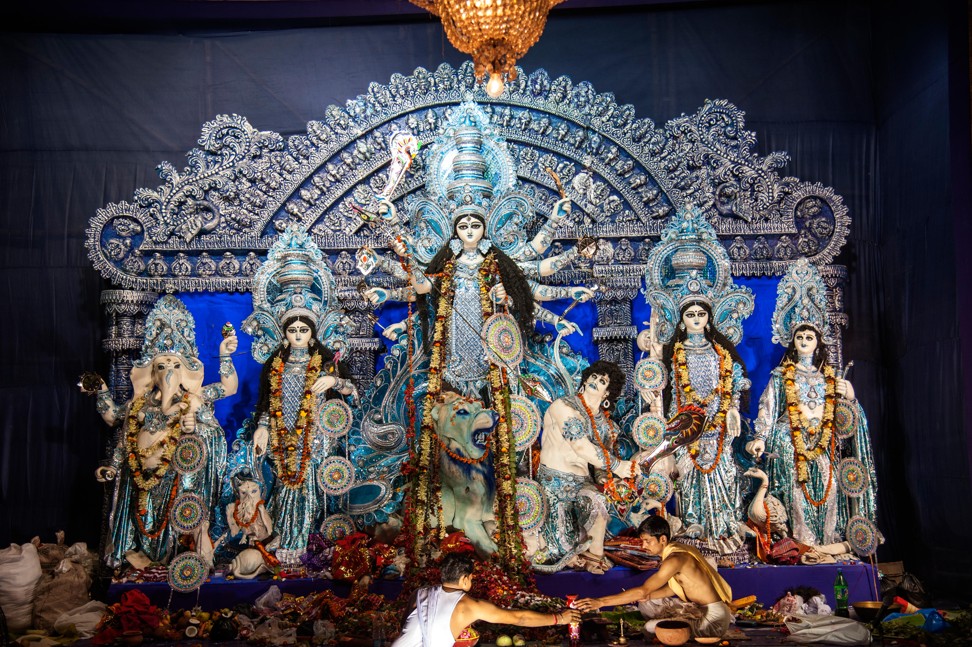
In Hindu mythology, Durga was created by the gods and imbued with their combined powers to end the terror wrought by Mahishasura, a demon empowered by a boon that made him immune from attacks by a god, man or beast. And so Durga, a woman, was created to get around the demon’s invincibility and vanquish him.
While her enduring image is that of a warrior, Durga is also worshipped in many other forms. As Parvati, consort to Lord Shiva, she takes on the role of loyal wife to her (sometimes eccentric) husband and caring mother to their divine offspring.
Beloved daughter of the King of the Himalayas, she willingly chooses a life of hardship alongside Shiva, who lives in the wilderness, over the royal comforts of her parents’ home. She symbolises marital happiness, fertility and devotion, and is affectionately called Ma Durga (Ma means mother).
And like a true goddess, she knows how to throw a party. Planning and budgeting for the larger Durga Pujas start almost from the time the previous puja ends and are undertaken by puja committees that function like fully fledged organisations.
We visit friends and family and greet one another saying ‘shubho bijoya’, meaning ‘auspicious victory’. It’s a heady mix of friends, family and the tastiest of foods
The committees choose the pandaal theme, hire artists and decorators, organise the devotional aspects of the festival, and sign up celebrity performers. They also arrange corporate advertising and sponsorships, logistics, security, and health and safety for the multitudes who take part every year.
Success is measured by the number of visitors a pandaal can attract as well as annual awards for creativity and innovativeness, which in turn drive sponsorships and budgets for the next year.
There are nearly 25,000 Durga Puja committees across West Bengal that organise and stage the celebrations, of which some 2,000 are estimated to be in Kolkata. The heritage puja committee Baagbazar marked 100 years of staging the festival in 2018 and has one of the oldest puja pandals in the city.
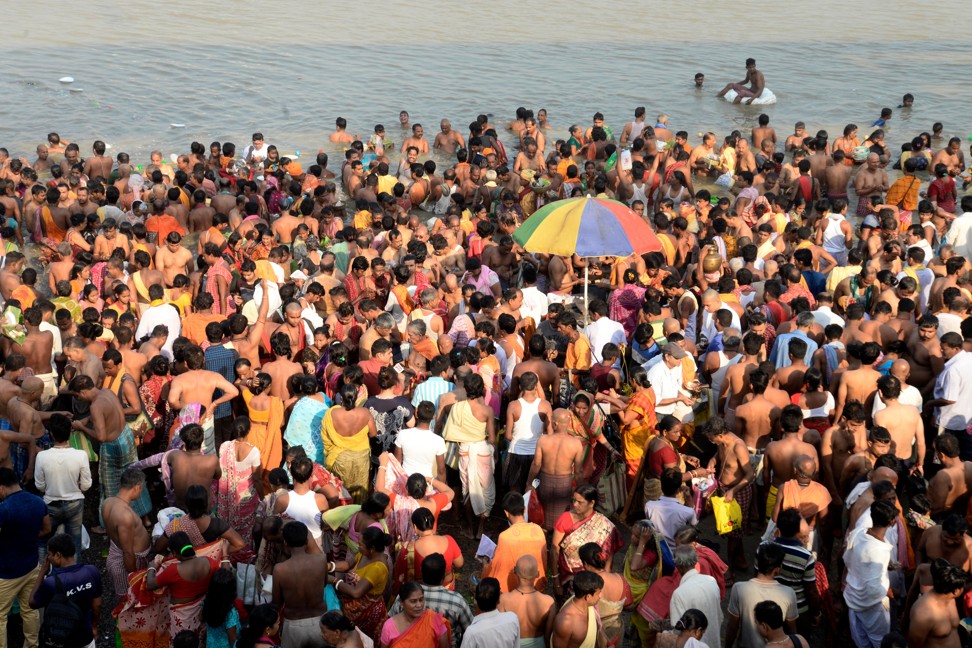
The first day of the 10-day festival is Mahalaya, which heralds the advent of the goddess.
“I remember waking up at dawn to the sound of hymns being recited on the radio, recounting the victory of Durga over Mahishasura,” says 68-year-old Indra Sen, a communications consultant who now lives in Delhi. “My sisters and I would huddle into our parents’ bed and it was a special moment for the whole family.”
Between Mahalaya and Shashti, the sixth day of the festival, the pandals are getting their finishing touches and statues of the goddess are almost ready to be unveiled. The figures of the goddess are usually fashioned by hand, from clay, and are made by a community of exalted craftsmen in Kumartuli, the traditional potters’ quarters in northern Kolkata.
“The celebrations begin in earnest on Shashti, when people welcome Durga and her children home,” Sen says. “[Officials in the] elaborately decorated pandals officially unveil the statue of the goddess on this day.”
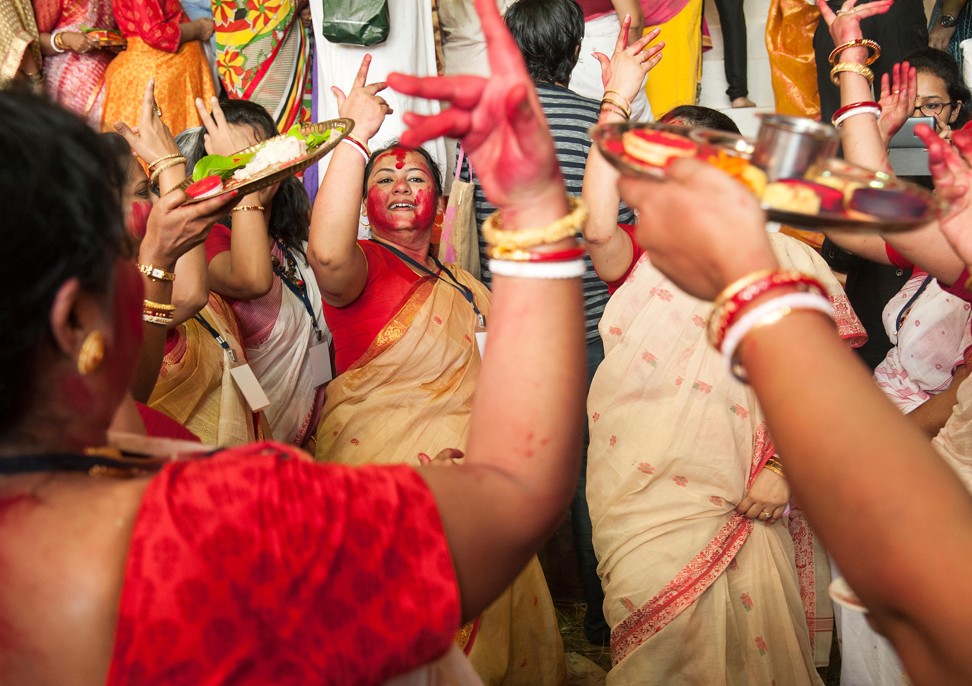
Married women visit their parents’ homes at this time during Durga Puja.
“The festival re-enacts the joy of Parvati’s parents, who eagerly look forward to their daughter’s annual arrival and their sadness at her departure,” explains 46-year-old Rupa Chakravorty, a professor at Hong Kong’s City University.
During her short stay away from the wilderness, the goddess is indulged, feted and rejuvenated by her parents before she returns to face the travails of being the wife to an ash-smeared Shiva.
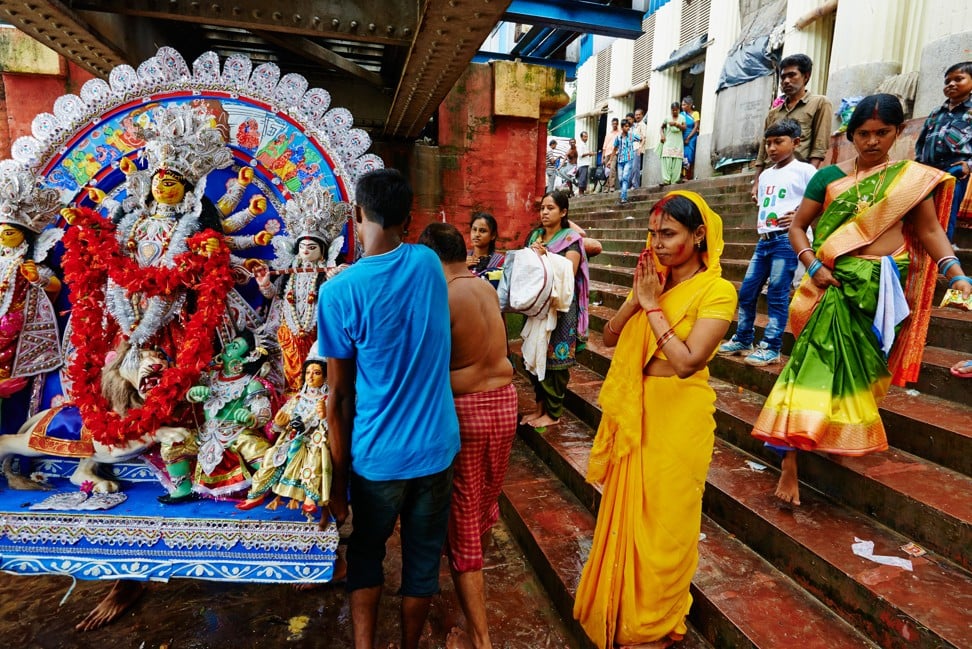
The seventh (Saptami), eighth (Ashtami) and ninth (Navami) days are the main days of Pujo and are celebrated with much passion and fanfare in the pandals.
“The mornings begin with worshipping the goddess with flowers, called pushpanjali,”, says Ananda Chakravorty, Rupa’s husband. Now 50, he is a banker who grew up in Kolkata and currently works in Hong Kong. “[It is] followed by bhog, food blessed by the goddess that is served for lunch, and ends at night with the breathtaking aarti and dhunuchi naach, a traditional dance performed with earthen pots filled with incense to the beat of the dhaks, drums.”
The festival culminates on the 10th day, called Vijaydashami, meaning the “day of victory”. It is the day that Durga defeated Mahishasura. Married women gather at the pandals and smear each other with sindur, a type of red cosmetic powder, in a tradition called Sindur Khela.
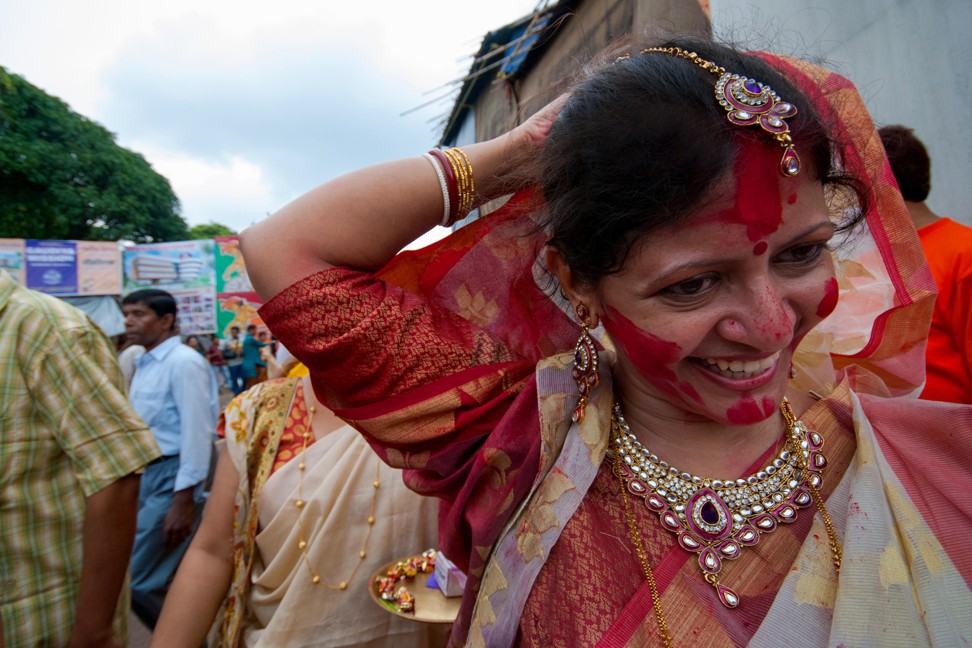
Huge processions carry colourful statues of Durga through the streets to the sound of the drums and chants, as they make their way to the Hooghly River, where the statues are immersed in the water. This symbolises the end of Durga’s sojourn on Earth and heralds her return to her home in the mountains with Shiva.
“We visit friends and family and greet one another saying ‘shubho bijoya’, meaning ‘auspicious victory’,” says Sengupta. “It’s a heady mix of friends, family and the tastiest of foods.”
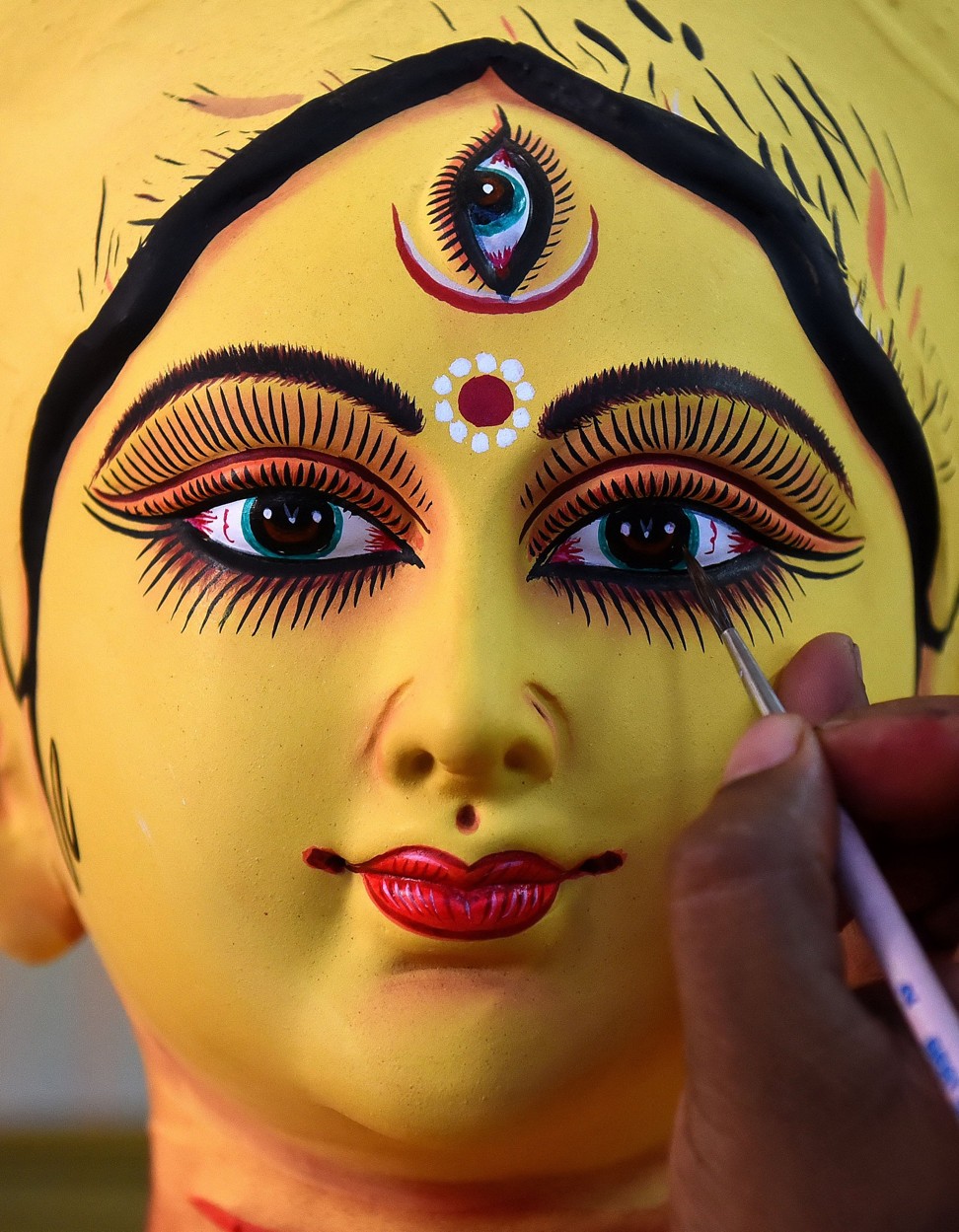
The 500 or so Bengalis in Hong Kong have been celebrating their most popular festival in a grand way for the past 20 years. After a few years at the Happy Valley Hindu Temple and the Henry G. Leong Yau Ma Tei Community Centre, Ma Durga has made the Indian Recreation Club at Sookunpoo Valley her home.
“Pujo means a week full of exuberance, food and laughter,” says Manjari Guha, cultural secretary of the Hong Kong Bengali Association. “It is an opportunity for us to teach our children, many of whom were born in Hong Kong, about Bengali culture and heritage.”